Living on Water: The Rise of Futuristic Lake Houses and Towers
March 25, 2025 | by alwaled

Introduction to Futuristic Architecture
Futuristic architecture represents a forward-thinking approach to design, capturing the essence of innovation, sustainability, and aesthetic appeal. In recent years, there has been a notable rise in the construction of lake houses and towers that embody these principles, transforming the way we interact with our natural environments. As we increasingly seek to harmonize human habitation with the delicate ecosystems around us, these architectural marvels offer a glimpse into the potential of aquatic living spaces.
The design of futuristic lake houses and towers often emphasizes fluid lines and organic shapes, mirroring the movement of water and the surrounding landscape. Utilizing advanced materials and sustainable construction techniques not only enhances the aesthetic appeal of these structures but also contributes to environmental stewardship. For instance, many of these buildings are constructed using eco-friendly materials that minimize their carbon footprint, ensuring that they coexist harmoniously with nature rather than dominating it.
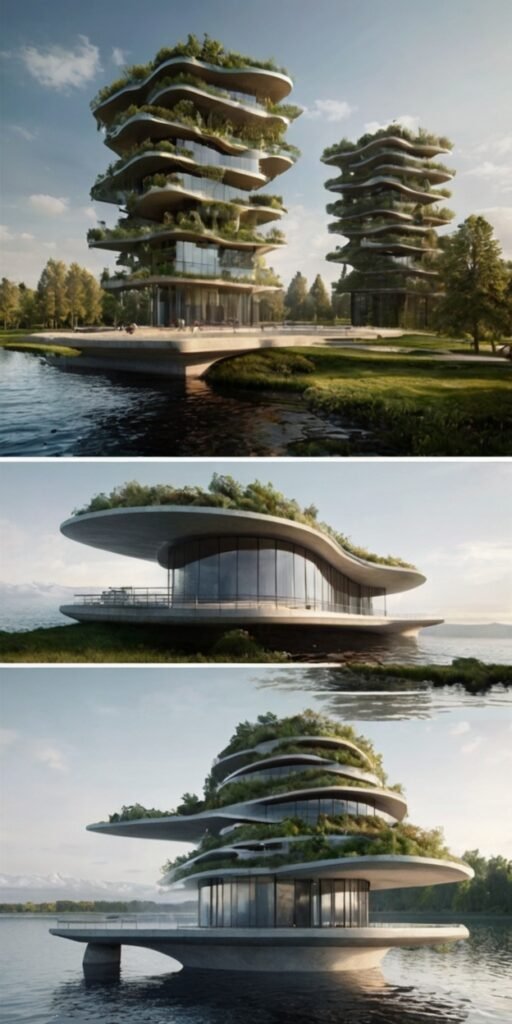

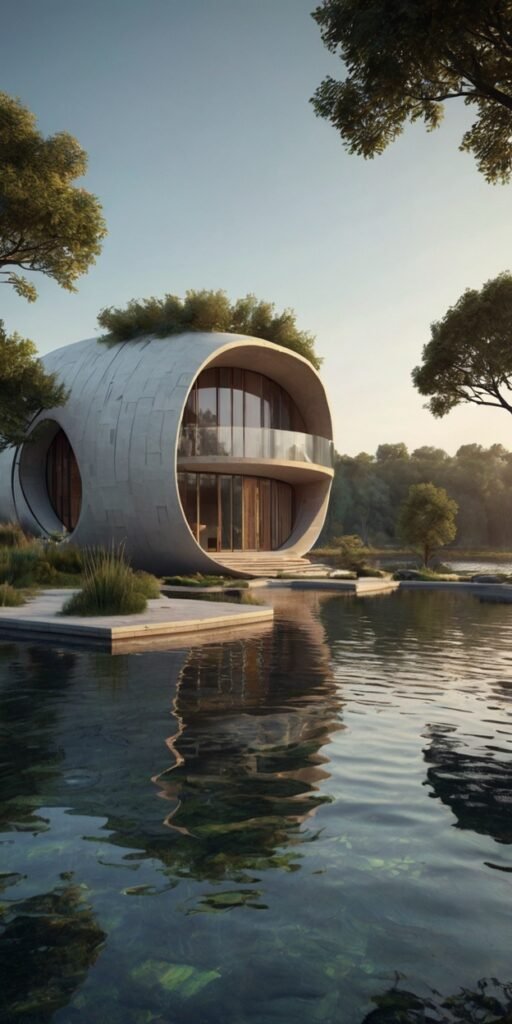

Moreover, the incorporation of sustainable technologies, such as solar panels, rainwater harvesting systems, and smart home technology, allows these structures to operate with minimal environmental impact while providing modern conveniences. Such technologies ensure that residents can enjoy the luxuries of contemporary living without compromising their commitment to ecological responsibility.
The growing interest in living on the water resonates with a desire for an unconventional lifestyle that connects individuals to their surroundings. As urban populations continue to expand, more people are looking for innovative housing solutions that offer serenity and the allure of nature. In this context, futuristic architecture stands out as a dynamic answer, presenting lake houses and towers not just as mere shelters, but as immersive experiences that enhance our relationship with water and nature.




Design Principles of Lake Houses and Towers
The design of futuristic lake houses and towers significantly diverges from traditional architectural conventions, embracing innovative methodologies that prioritize sustainability, functionality, and aesthetic appeal. Central to this design philosophy is the principle of biomimicry, which involves drawing inspiration from natural systems and organisms to create efficient and sustainable structures. Architects studying nature’s forms, materials, and processes can imbue lake houses and towers with characteristics that promote harmony with the surrounding environment. This approach not only elevates aesthetic value but also enhances the livability of these structures by ensuring that they fit seamlessly within their ecosystems.
Another pivotal aspect of contemporary lake house and tower design is modular design. This principle allows for the construction of flexible and easily adaptable units that can meet various living requirements. Modular components can be prefabricated, effectively minimizing construction waste while enabling swift assembly on-site. This adaptability makes it possible for these structures to change in response to the environment, catering to fluctuating water levels and seasonal weather variations. Such a design method aligns perfectly with the dynamic nature of lake environments and encourages resilience against climate change effects.








Furthermore, an eco-friendly approach underlies both the design and construction processes of these buildings. Utilizing sustainable materials, implementing energy-efficient systems, and integrating renewable energy sources such as solar panels or wind turbines are vital components of this eco-friendly ethos. Builders and architects increasingly prioritize reducing carbon footprints, promoting water conservation measures, and utilizing greywater systems to minimize environmental impact. By adhering to these design principles, lake houses and towers not only provide unique living experiences but also collectively contribute to a sustainable future in architectural design.

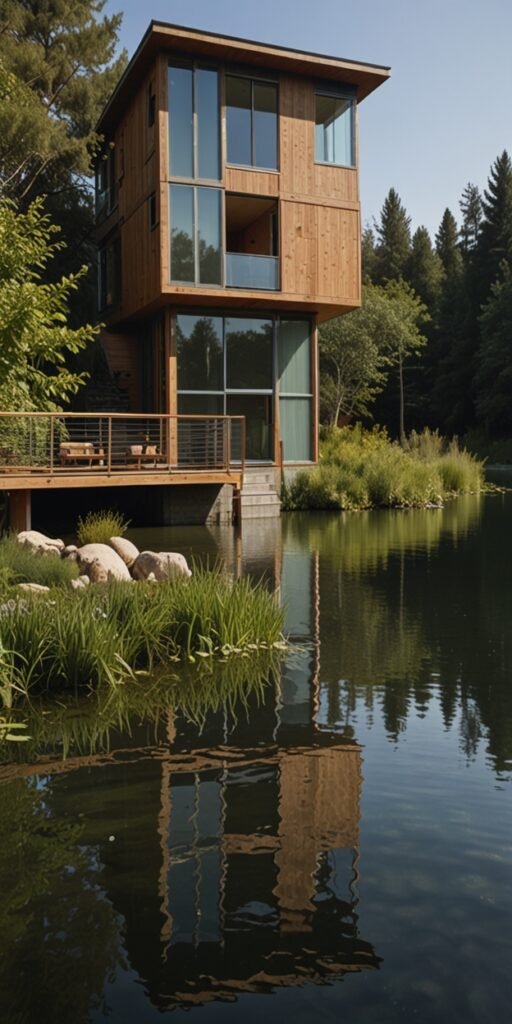


Sustainable Living Features and Technologies
The rise of futuristic lake houses and towers significantly emphasizes sustainable living, incorporating advanced technologies and innovative features designed to minimize environmental impact. As communities become more aware of climate change, these structures not only prioritize aesthetic appeal but also highlight the importance of eco-friendliness. One prominent aspect of these designs is the use of renewable energy systems. Solar panels and wind turbines are commonly integrated into the architecture, harnessing natural energy to power the homes efficiently. This reliance on renewable resources allows residents to significantly reduce their carbon footprint, contributing to a more sustainable lifestyle.
In conjunction with renewable energy, water filtration systems play a crucial role in promoting sustainability in lake houses and towers. These systems typically include rainwater harvesting techniques and advanced filtration processes which allow residents to collect and purify rainwater for daily use. This is especially vital for structures situated in remote areas, where access to clean water may be limited. By utilizing water filtration systems, these buildings manage to conserve local water resources while providing an essential utility for their occupants.


Furthermore, smart home technologies integrate seamlessly with traditional architectural elements in lake houses. These technologies allow residents to monitor and control energy usage, adjusting heating, cooling, and lighting to optimize resource consumption automatically. By employing smart thermostats and energy-efficient appliances, homeowners can significantly lower their energy demands. Additionally, smart home systems provide real-time feedback, enabling users to make informed decisions about their living habits and further reduce their environmental impact. Through the successful integration of renewable energy systems, advanced water filtration technologies, and smart home automation, futuristic lake houses and towers provide a model for sustainable living that promotes self-sufficiency and environmental stewardship.
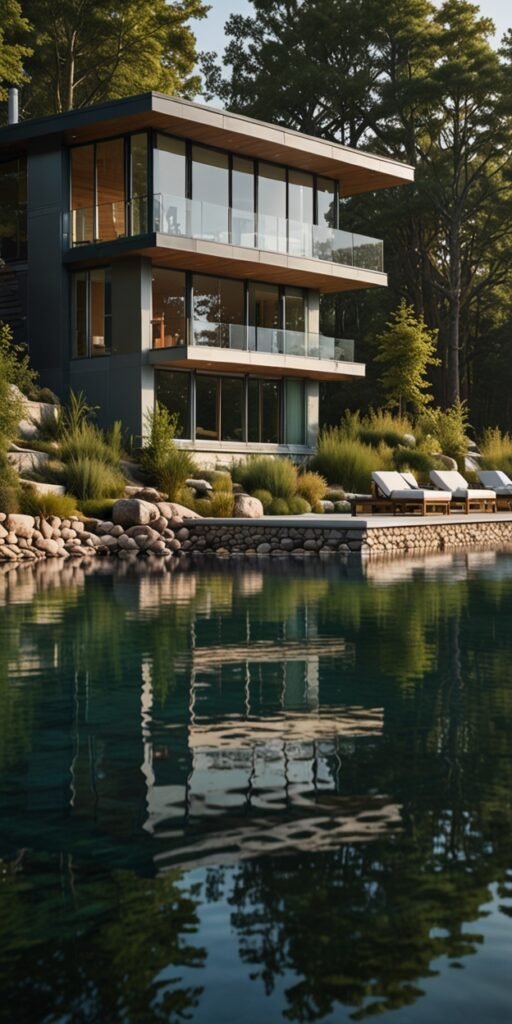


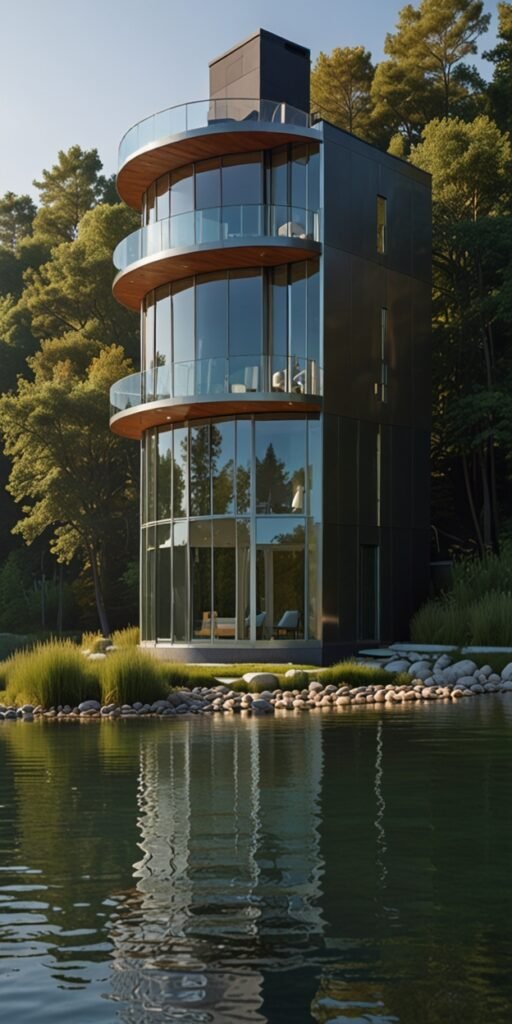
Case Studies of Innovative Lake Houses
As the concept of living on water gains traction, several innovative lake houses have emerged, reflecting a harmonious blend of architectural creativity and environmental consciousness. These structures not only provide stunning living spaces but also embody the principles of sustainable design. Below, we explore three notable case studies that exemplify this futuristic movement.
The first case study focuses on the Floating House in the Netherlands. Designed by studio Marlies Rohmer, this remarkable structure is built on a series of pontoons, allowing it to rise and fall with the water level, thus mitigating the impact of flooding. The house features a sleek, modern aesthetic with large glass windows that offer panoramic views of the surrounding lake. Its double-skin facade enhances insulation while reducing energy consumption, making it a prime example of sustainable architecture. The Floating House illustrates how adaptability to changing environmental conditions can redefine waterfront living.




Next, we explore the unique design of the WaterNest 100, located in Italy. This futuristic lake house, designed by Giancarlo Zema, is constructed from environmentally friendly materials and features a striking circular shape that maximizes space while minimizing its ecological footprint. The structure is elevated above the water, built on stilts that ensure stability and protect against rising water levels. The extensive use of solar panels and rainwater collection systems not only provides energy efficiency but also reinforces its commitment to sustainability. The WaterNest 100 stands as a testament to the potential of eco-friendly architecture in a lakeside context.
Lastly, the Arkup House takes innovation a step further by integrating mobility into its design. This luxurious floating home, developed by Arkup, is equipped with a hydraulic system that elevates it above the water during floods. The house is powered by solar energy and features a smart, eco-conscious living space. Designed to be mobile, it can be relocated according to seasonal changes, embodying the future of dynamic lake house living. Each of these case studies illustrates how futuristic lake houses can prioritize both aesthetics and environmental sustainability, paving the way for a new era of residential design on water.




The Impact of Location on Design
The location of a lake house or tower plays a pivotal role in shaping its architectural design and material selection. Situated on or near bodies of water, these structures must account for various environmental factors that significantly influence their durability and aesthetic appeal. One primary consideration is the local climate, which affects design choices related to insulation, ventilation, and overall structure resilience. For instance, homes located in areas prone to heavy rainfall or storms must incorporate features that prevent water damage, such as elevated foundations and robust drainage systems.
Moreover, the fluctuations in water levels can dictate the type of materials utilized in construction. Properties situated in regions with significant tidal variations or seasonal changes may benefit from using corrosion-resistant materials like treated wood, stainless steel, or concrete engineered for moisture exposure. These choices not only enhance structural integrity but also complement the natural environment while ensuring the longevity of the building. This adaptability is crucial as fluctuating water levels can impact not just the aesthetic, but also the functional aspects of the design.




Additionally, understanding the local ecosystems where lake houses are built is essential for sustainable development. Structures designed with environmental sensitivity can help preserve the natural habitat, integrating features such as green roofs or permeable walkways that minimize disruption to local wildlife and plant life. Employing sustainable materials derived from renewable resources further underscores a commitment to environmental stewardship, fostering a harmonious relationship between the built environment and nature.
In light of these factors, architects must approach design with a comprehensive understanding of the unique challenges presented by their chosen site. Effectively merging location characteristics with innovative design strategies leads to the creation of lake houses and towers that are not only visually stunning but also resilient and eco-friendly.


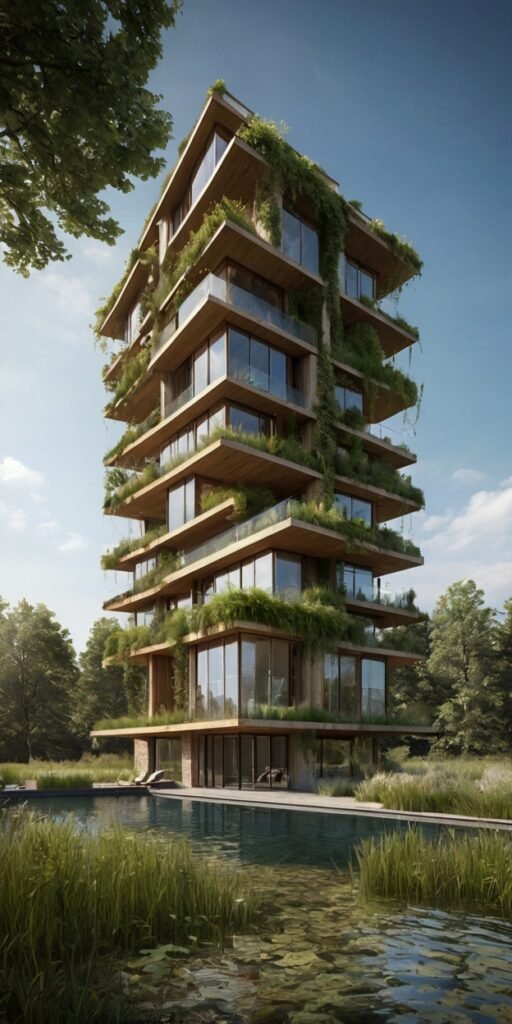

The Future of Urban Living: Lake Towers as Urban Extensions
The concept of lake towers represents a transformative approach to urban living, addressing the pressing challenges of space and sustainability in densely populated cities. As urban areas continue to grapple with overcrowding and limited land availability, these innovative structures offer an alternative to traditional land-based development. Positioned above serene bodies of water, lake towers are designed not only to provide housing but also to create a harmonious relationship between nature and urban life.
Vertical living spaces in lake towers foster a unique lifestyle that prioritizes both comfort and recreational opportunities. Residents can enjoy stunning waterfront views, direct access to outdoor activities, and community amenities that enhance the quality of life. The allure of lake towers resides in their ability to integrate urban functionality with the tranquility offered by water environments. This combination supports a harmonious community atmosphere, promoting a sense of well-being among inhabitants.


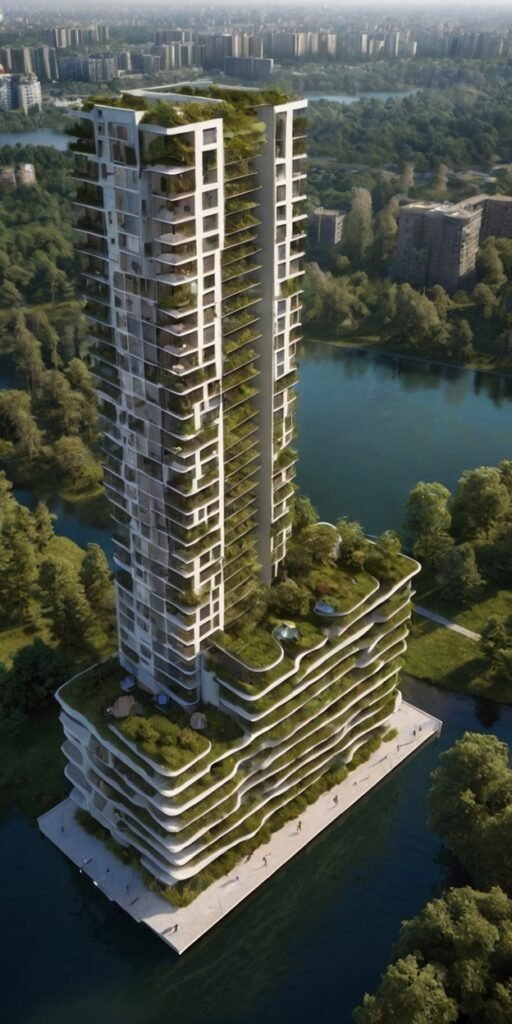

Furthermore, these innovative structures can significantly reduce the environmental impact typical of traditional urban developments. By utilizing advanced building technologies and sustainable practices, lake towers promise to decrease the carbon footprint associated with urban living. Technologies such as solar panels, rainwater harvesting systems, and efficient waste management systems are often incorporated, allowing these buildings to operate in an eco-friendly manner.
The rise of lake towers also initiates a shift in urban planning philosophies, encouraging cities to expand beyond their land confines and embracing the water-based environments around them. As urban centers search for innovative solutions to accommodate growing populations, lake towers serve as a vital reflection of modern architectural trends, promoting sustainability while enhancing metropolitan living experiences. The future of urban living may very well depend on our ability to adapt to and utilize the space provided by nature’s water bodies.




Challenges in Building on Water
The emergence of lake houses and towers has revolutionized the concepts of modern living, yet constructing these innovative structures presents a unique set of challenges. One of the primary hurdles is navigating the complex web of legal regulations that govern building on water bodies. Each region has its own set of laws regarding land use, water rights, and environmental protections, which can significantly vary. Builders must often engage in extensive research and consultations with legal experts to ensure compliance with local and federal statutes, which can delay projects and increase costs.
In addition to legal challenges, water safety concerns add another layer of complexity to building on water. The construction of lake houses and towers must account for potential risks such as flooding, storms, and erosion. Engineers must design structures capable of withstanding these natural phenomena, requiring advanced materials and techniques that can raise the overall expenditure. Furthermore, ensuring the safety of residents and visitors in such environments necessitates comprehensive planning and rigorous safety protocols, which may include life-saving equipment and emergency evacuation routes.




Environmental impact is another significant consideration when creating homes on water. The construction process itself can disturb local ecosystems, while permanent structures may alter water flow and disrupt habitats. Builders must work closely with environmental specialists to evaluate the potential ramifications of their projects. This often involves conducting environmental assessments and adhering to sustainable practices to minimize the ecological footprint. Consequently, navigating the balance between innovative architectural design and environmental stewardship remains a pressing challenge for architects and builders involved in lake house and tower projects.
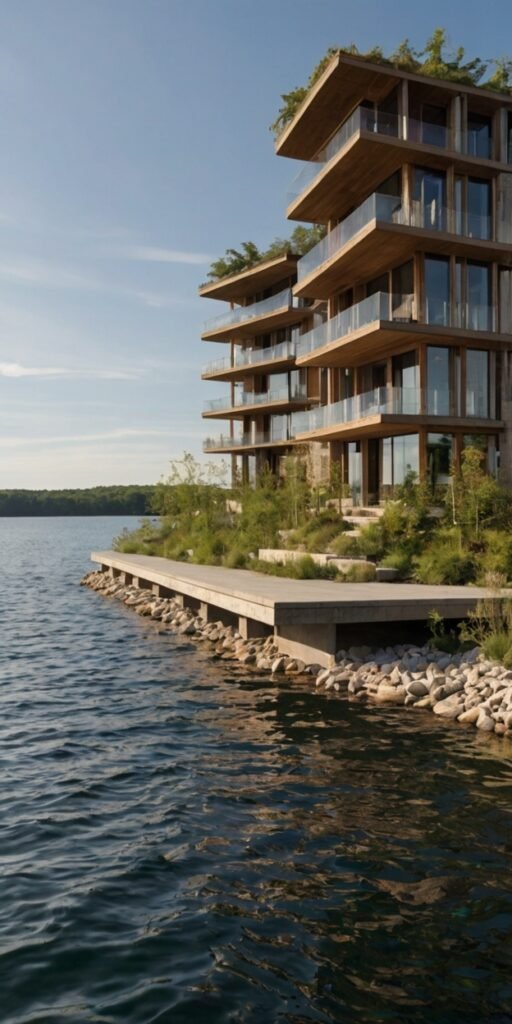



The Future of Lake Houses and Towers: Trends and Predictions
Lake houses and towers are evolving rapidly as architectural designs adapt to modern demands and environmental considerations. Over the next decade, several notable trends are anticipated to shape this movement, offering insights into both aesthetic and functional elements of future constructions. One significant trend is the use of sustainable materials. As awareness of climate change grows, architects and builders are increasingly turning to eco-friendly resources such as reclaimed wood, bamboo, and recycled metals. These materials not only reduce environmental impact but also enhance the overall aesthetic appeal of the structures by lending them a natural, organic aura.
Moreover, the integration of advanced technology into lake houses and towers is becoming commonplace. Smart home technology, such as automated climate control and energy-efficient systems, will significantly enhance comfort and efficiency. Future designs are likely to include features that resonate with the principles of sustainability, utilizing solar panels and water recycling systems to minimize reliance on external resources. Additionally, advances in insulation materials will allow buildings to maintain a stable internal climate, critical for homes located in varying weather conditions.




Consumer preferences are also shifting towards multifunctional living spaces. With the rise of remote work, lake houses are increasingly designed with hybrid spaces that accommodate both leisure and work environments. This trend emphasizes open layouts that allow for flexible usage while maintaining a connection to the surrounding natural landscape. Furthermore, an emphasis on outdoor living spaces, such as expansive decks and patios, will likely become a standard in lake house design, enhancing residents’ connection to the water and outdoor environment.
In conclusion, the future of lake houses and towers encompasses a blend of sustainability, technological advancements, and responsive consumer design preferences. As these elements are increasingly incorporated into architectural planning, the upcoming decade promises to witness unique and innovative structures that redefine lakeside living.
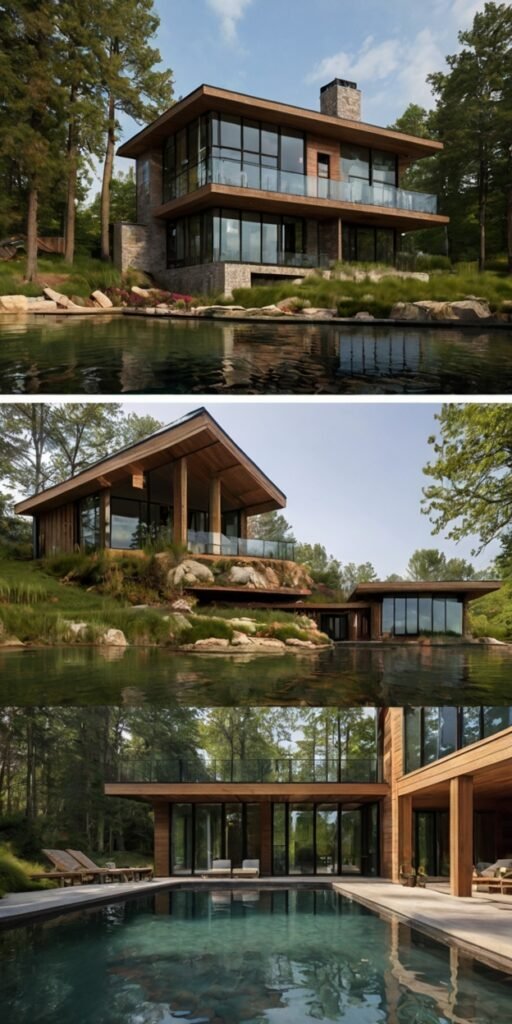


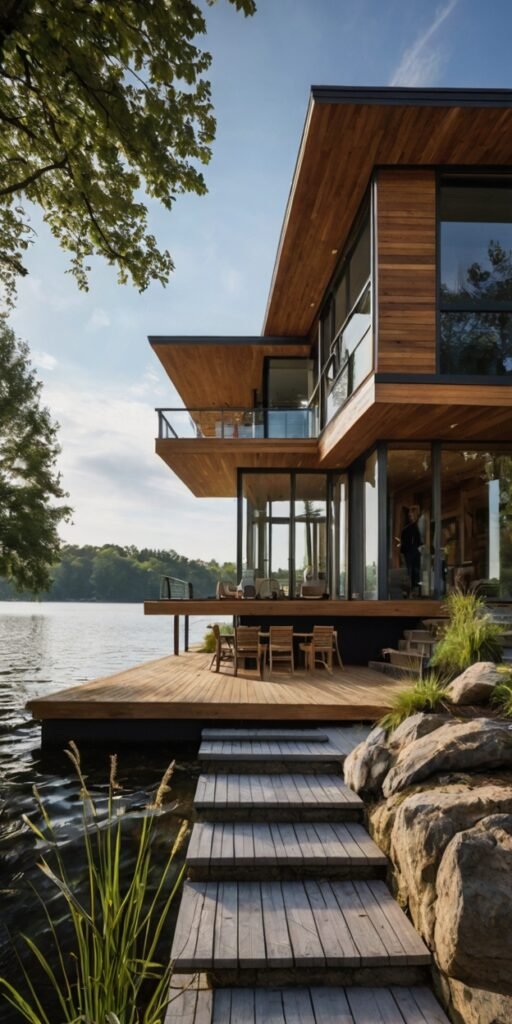
Conclusion: Embracing Aquatic Living
As societies evolve and face the challenges of urbanization, pollution, and climate change, the concept of aquatic living is gaining significant traction. Futuristic lake houses and towers represent an innovative approach to living that harmonizes residential needs with environmental sustainability. These structures are designed not only for aesthetic appeal but also with practicality and resilience in mind, reflecting a deep understanding of both water dynamics and the spatial requirements of modern life.
The unique nature of these floating homes offers a compelling solution to the issues presented by overcrowded cities and rising sea levels. By anchoring living spaces on water, architects and city planners are creating sustainable communities that respect natural ecosystems while providing residents with a tranquil and picturesque lifestyle. Environmental considerations are at the forefront of this architectural movement, ensuring that these buildings utilize renewable energy sources, efficient water management systems, and sustainable construction materials. This, in turn, allows for a minimal ecological footprint.




Moreover, the allure of lake houses and towers extends beyond their functional attributes. The serene landscapes and unparalleled views are significant draws for individuals seeking a retreat from the frenetic pace of urban life. Textures of water reflections and the soft sounds of rippling waves contribute to a unique sensory experience that cannot be replicated in traditional housing. The blend of comfort, sustainability, and aesthetic enjoyment creates a lifestyle that appeals to a diverse range of people, encouraging new forms of community interaction and environmental stewardship.
Embracing aquatic living offers an exciting vision of the future, where we can envisage a harmonious coexistence with nature. It invites individuals to reconsider their living environments and the potential for innovative designs. The rise of futuristic lake houses and towers marks a transformative direction in architecture, encouraging adaptability and a renewed commitment to sustainability.


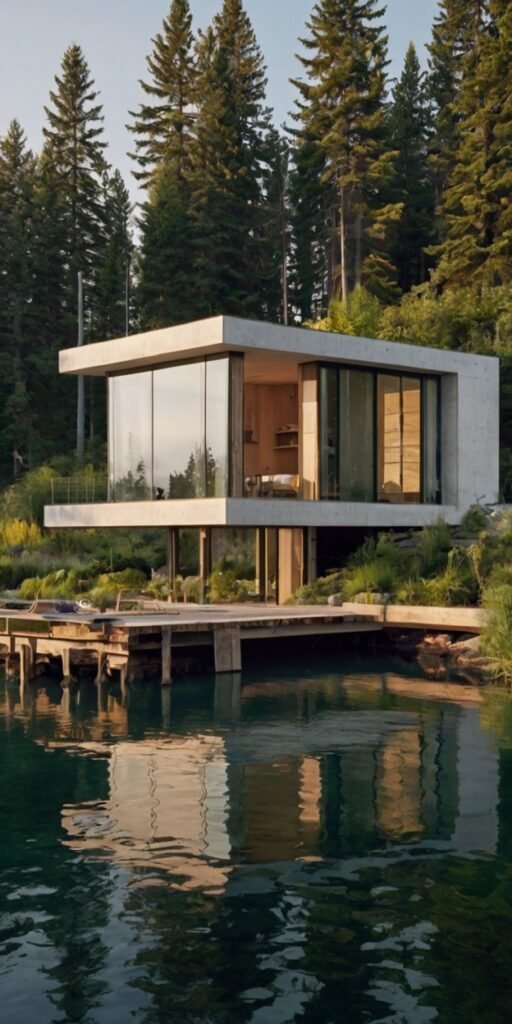

RELATED POSTS
View all


